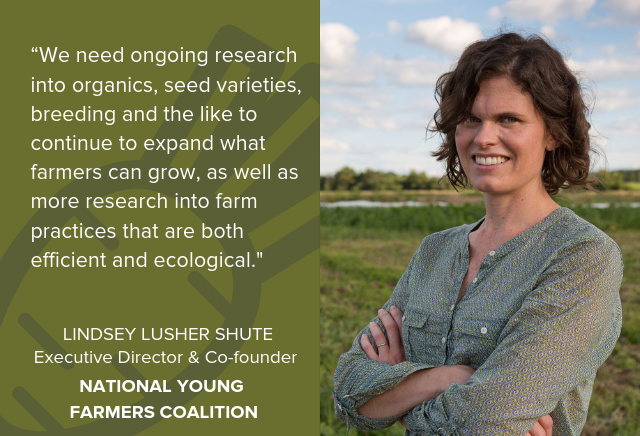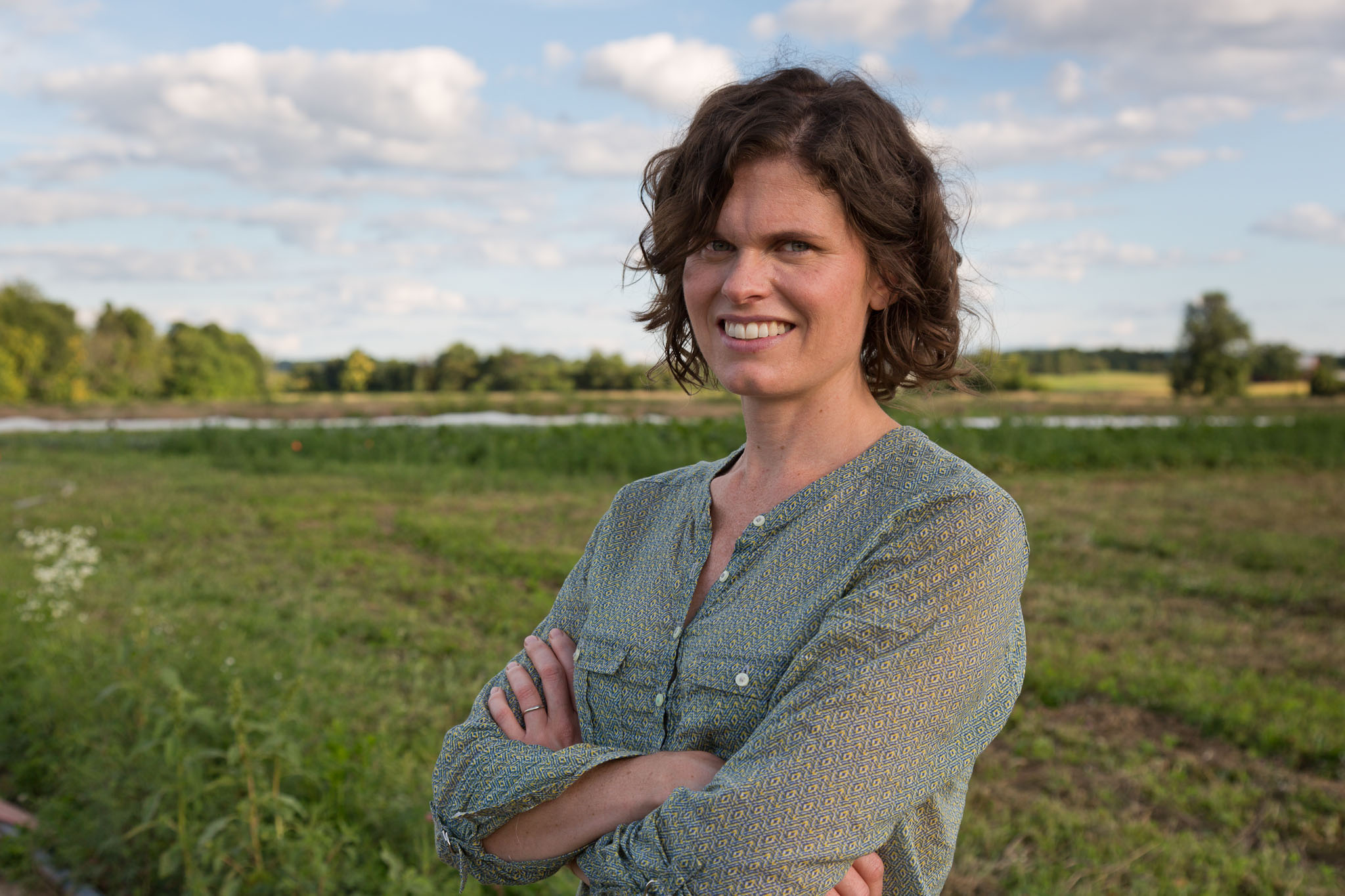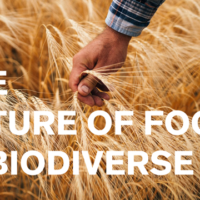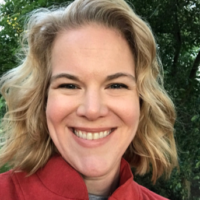
Food+Tech Connect and The Future Market are hosting Biodiversity: The Intersection of Taste & Sustainability, an editorial series featuring interviews with over 45 leading food industry CEOs, executives, farmers, investors and researchers on the role of biodiversity in the food industry. Read all of the interviews here.
The National Young Farmers Coalition is an organization dedicated to helping young farmers succeed. Below, I speak with executive director Lindsey Lusher Shute about why biodiversity is critical to the future success of agriculture in the United States, what policies and investments are needed to help farmers cultivate more biodiverse farming operations and what eaters can do to support a more biodiverse food system.
______________________
Danielle Gould: Is biodiversity a priority for National Young Farmer Coalition? If so, how and why?
Lindsey Lusher Shute: Biodiversity is an important component of our mission as we support the policies and practices that enable a more sustainable, successful future for U.S. agriculture. According to our latest farmer survey, practices that support biodiversity are also a priority for young farmers: 75 percent of our farmers practice sustainable methods, 63 percent follow organic standards and 81 percent of our farmers run diversified operations.
DG: How does the National Young Farmers Coalition define and think about biodiversity? What does an ideal biodiverse food system look like?
LLS: On a farm, biodiversity means not only the plants, invertebrates, mammals, birds, amphibians, reptiles and fish that already live there — but also what we as farmers introduce to the landscape.
I can’t imagine an upper limit for biodiversity, and particularly in this moment when we are seeing the collapse of biodiversity on a global scale. It’s frankly hard to even describe what “good” might mean when it comes to biodiversity because there are still so many discoveries being made. We are a long way off from knowing even the extent of life on this planet and the interwoven nature of it all.
DG: As a farmer, how do you think about biodiversity?
LLS: On our farm, we’ve collaborated with the Hawthorne Valley Farmscape Ecology Program to look at insect biodiversity on our farm and how beneficial insects interact with pests. Over the course of the research on our property, they found three kinds of butterflies that we didn’t even know about: the Fiery Skipper, the Common Buckeye and the Hackberry Emperor. With wild pollinators responsible for pollinating half of all food crops, knowledge of these native species and the habitats that support them is incredibly valuable.
Biodiversity is meaningful to Ben and I because we want our farm to support life in all of its forms, and also because we know that biodiversity is critical to the farm’s success.
DG: What is National Young Farmer Coalition doing or planning to do to promote biodiversity?
LLS: Biodiversity cannot be achieved on one farm alone; policy and practices across the globe impact the health of our land and the biodiversity of our individual farms. We have spoken out on behalf of our farmers on many issues that impact biodiversity: land use changes, climate change, seed biodiversity, pesticides and herbicides, sustainable farm practices that are intended to work in tandem with the natural environment.
We advocate with our farmers, bringing producers from across the country to Washington, DC to ask Congress to support conservation policies that support and encourage biodiversity on the farm. Lastly, we also work to empower young farmers who are passionate environmentalists and farm in a way that supports biological diversity.
DG: What is the business case for biodiverse agriculture?
LLS: There is no farmer, no matter the scale or practice, who doesn’t recognize the importance of biodiversity. Farmers continuously rely on the bounty of nature and ingenuity of science to help them grow healthy crops.
That said, I would like to see more farmers embrace seed and breed biodiversity because what farmers choose to buy and grow on their farms today has an real impact on future farm biodiversity. When we no longer use a seed variety or only raise a certain kind of livestock — promoting, say, certain traits for economic efficiency alone — our community intentionally narrows the genetic diversity in agriculture.
And really that’s the crux of it: in a world with climate change, we need choices and regionally adapted varieties of seed and breeds. With choice, and with diversity, we reduce risk and build needed resilience.
DG: What investments need to be made to create a more biodiverse food system?
LLS: Farmers need to be supported as they implement conservation practices that increase biodiversity. A farm conservation plan, as currently required by USDA, should incorporate more measures of biodiversity and considerations for increasing it on each farm. We need ongoing research into organics, seed varieties, breeding and the like to continue to expand what farmers can grow, as well as more research into farm practices that are both efficient and ecological.
And lastly, we must address climate and land use. The nation must invest in a new economy that will drastically reduce our carbon footprint and halt global warming, and we need to protect our natural landscapes and habitats from fragmentation and development. All of these things — smart planning, research, science and conservation —represent major investments.
DG: What are the greatest challenges and opportunities farmers face for creating a more biodiverse system? What are you doing to overcome or capture them?
LLS: This might not be an obvious answer, but one of the most difficult issues for our farmers is land ownership. Without land ownership very few of our farmers can make investments into farm infrastructure and conservation that could adequately address the global crisis of biodiversity. Who owns and manages our landscapes is a critical question.
We also hear from many farmers about their need for extension and technical support services for organics and sustainable agriculture. This is a major need.
And lastly, we need to take a hard look at pesticides and herbicides and how they are impacting biodiversity. The recent issues around dicamba are a stark reminder of the negative impacts that farmers can have on the environment, and an impact that can extend well beyond the farm.
DG: How might we get more farmers to invest in biodiverse agriculture?
LLS: First and foremost, farmers need to own land. After that, they need low-interest loans or grants to support the cost and a consumer who is willing to pay a little more for food grown with practices that support a healthy ecosystem.
Research that makes the economic case for biodiversity may also encourage these practices. If you can demonstrate that improved diversity ultimately boosts productivity and sales potential, many more farmers may make the transition. As we’re already seeing, the increased consumer demand for sustainably grown products, even at higher price points, is also enabling farmers to invest in these practices.
Lastly, ensure that farmers, including beginning farmers and farmers of color, have access to key conservation programs so incentives are distributed equitably to farmer to promote biodiversity on their farms and ranches.
DG: What are some of the most important things food manufacturers, retailers, chefs and other key actors across the food supply chain can do to support biodiverse agriculture?
LLS: Buy local. Make the effort and deal with the small quantities that may be available now — because your purchases will help a farm and a farm community grow. I’ve also been impressed with Dan Barber and other chefs who are actively seeking to expand the varieties available to them, and who are working directly with farmers on breeding.
DG: Are there certain products you would like to see more of in the food industry — either in foodservice or CPG — that would help promote a more biodiverse agricultural system?
LLS: Again, I just want to have the opportunity to buy more products that were made by family-scale farmers with good practices. I also think that the entire idea of “foodservice” does not lend itself to biodiversity. When an institution is seeking perfect uniformity of weight or size or fat content, they are naturally limiting diversity of what’s grown. To address biodiversity, the entire industry would require a significant shift in priorities and different expectations for preparation and price.
DG: What is your vision for what a more biodiverse food system looks like in 10-15 years?
LLS: I’ll just say that 10-15 years is lightning fast when it comes to farming and agriculture. We have moved so far from animal and crop production that truly reflects a diverse food system, that I know it will take decades to build something that’s truly different on the ground. That said, I do think that we’re on our way in many respects and I am so hopeful about the young people I see farming today who care deeply about these issues. As these farmers take more leadership in the food system, we see positive shifts.
A more biodiverse food system must be fundamentally based on a system that defaults to locally grown products and is prepared for differences and diversity in ingredients. It is a system where consumers put even greater value on food that is grown with community in mind, with biodiversity in mind and is willing to be a little bit slower overall.
The idea of “slow” and “patient” is a fundamental value in a biodiverse system. We must take the time to listen and observe the environment around us, and work with it as we grow food; consumers must take the time to buy local products and support biodiversity and sustainable practices with their food budgets; and communities must take the time to listen to each other and advance innovative solutions to land use, climate and the pressing environmental issues of our day.
Read all of the interviews here and learn more about Biodiversity at The Future Market.
___________________________________
 Lindsey Lusher Shute, Executive Director and Co-founder of the National Young Farmers Coalition
Lindsey Lusher Shute, Executive Director and Co-founder of the National Young Farmers Coalition
Under Lindsey’s leadership, Young Farmers grew from a few volunteer farmers to a nationwide network with 42 chapters in 28 states and a base of over 150,000. Lindsey has edited and authored nine reports for the coalition, including Building a Future with Farmers: Challenges faced by Young, American Farmers and a Strategy to Help Them Succeed. This report established Young Farmer’s first policy platform and was the first to survey the nation’s millennial farmers. Farmland Conservation 2.0: How Land Trusts Can Save America’s Working Farms and a New York Times op-ed, “Keep Farmland for Farmers”, launched a national land access campaign that engaged hundreds of land trust professionals in making farmland affordable for future generations of farmers.
The coalition has become a force for leadership development and grassroots campaigns. It has passed 4 state laws and recently won hundreds of millions of dollars for small and sustainable farms in the 2018 Farm Bill. The national network of chapter leaders is now a pathway to leadership for young farmers, helping them raise their voices at the local, state and national levels.
Lindsey regularly speaks at conferences and to national media on farm issues, and was recognized as a “Champion of Change” by President Barack Obama. She was named among “20 Food Leaders Under 40” by Food Tank, and an “American Food Hero” by Eating Well Magazine. Lindsey holds a M.S. in Environmental Policy from Bard College and a BFA from New York University.
Lindsey and her husband, Benjamin, own and operate a 900-member CSA farm in Columbia County, New York.





